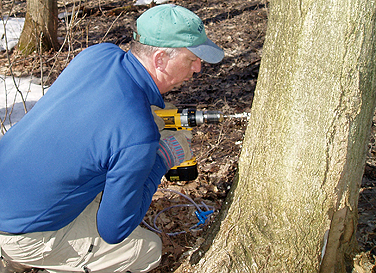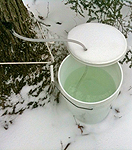News
Maple syrup a spring ritual for Weber

Scott Weber uses a drill to tap a maple tree.
-
 Print
Print -
 Comments
(2)
Comments
(2)
-

The sap collects in a bucket.
Scott Weber is in his car heading from Buffalo toward Cattaraugus County. His annual trips to Perrysburg are as much a sign of spring as melting snow, new buds and warmer days.
The drive to the small Southern Tier hamlet takes Weber, vice provost and dean of undergraduate education, about an hour, the first hour of many as he begins the process of making maple syrup.
“I have a friend with about 100 acres in Perrysburg,” he says. “That’s where I tap trees.”
Weber had no experience when he started making syrup about 15 years ago, yet the idea was intriguing to him.
“I’ve always wanted to do something different in the different places I’ve lived,” he says. “Since I grew up on a farm, producing maple syrup seemed interesting.”
In fact, Weber says producing maple syrup is really a testimony to his father, who raised beef cattle on an 80-acre farm in Virginia.
“Producing syrup was a chance for me to honor him by harvesting something from the land.”
But the harvest cannot begin until the conditions are right. The maple syrup season is not determined by the calendar specifically, but by the weather.
“The trees have to be ready,” he says. “I look for days when the temperature moves from lows in the mid-20s to highs in the mid-30s.”
That weather pattern is a seasonal signal for trees which, during the winter, behave like hibernating animals. Those cold months send the forest into a semi slumber, a time when a tree’s growth nearly stops. But the sap in trees starts flowing again when the daytime and nighttime temperatures begin straddling the freezing the point. That’s when the trees—and Weber—get to work.
“I get all my stuff,” he says excitedly, waving his arms as though collecting imaginary drills, taps and buckets. Certainly, his words flow faster than what drips from the trunks. In fact, to hear Weber describe the process is to realize that “run” does not appropriately describe the behavior of sap as it is being collected. There is no deluge. Producing maple syrup takes time and he is not in a hurry.
He takes out his cell phone to show a reporter a picture of the fire pit he’s built, an ancient device displayed on a modern one. The fire pit acts as an evaporator, with heat from its lonely flame pushing the raw sap closer to being finished maple syrup.
“I’ll sit on a log by the fire and watch the land,” he says. “A mouse might come out to sit with me by the fire. He’ll look at me and I’ll look at him before he scurries off thinking he should be someplace else.”
The mouse may have left, but Weber is not going anywhere. He revels in those moments, when a red tail hawk might fly overhead or when the day’s quiet is punctuated by the call of a downy woodpecker, whose voice is as sharp and clipped in the morning air as the sound of its beak drumming on the limb of a tree that Weber may have tapped. The evenings are lit only by the collaboration of the full moon and the fire from the evaporator, boiling down sap. A coyote howls. Weber is alone. And that is a cherished aspect of his time in the woods.
“I work with fantastic people,” he says. “But the forest is an opportunity for solitude.”
There are no amenities on these trips. His friend may provide the land, but nothing else. There is nothing else. Weber spends his nights in a tent. Luxury living, he calls it, being a seasoned winter camper who is accustomed to the challenges of that pastime. Yet Perrysburg is not without its own risks.
“I’ve never seen a black bear,” he adds, almost as an afterthought, before a look of concern crosses his face. “I hope I never do see one. I don’t want to give up any of my sap.”
It’s easy to see why. The sap is precious.
Four hundred gallons of sap produce only five to 10 gallons of maple syrup—and Weber will give most of it away to friends.
“This is a big part of me,” he says. “My friends know that and they know the work that goes into it.”
It’s precious time well spent.
“I can’t give a better gift than that,” he says.

Reader Comments
Pat Carey says:
What a fun thing to do to celebrate spring! And what lucky friends Scott has!
Posted by Pat Carey, Staff, 03/29/12
Scott Meier says:
Nice story, well-written.
Posted by Scott Meier, Professor, 03/29/12